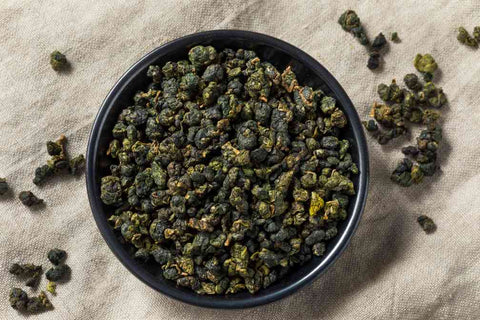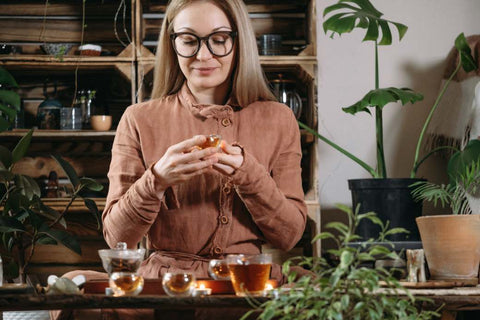For tea lovers seeking a unique and flavorful experience, milk oolong tea presents a captivating option. Unlike the name suggests, milk oolong doesn't contain actual milk. Instead, this distinct oolong tea boasts a naturally creamy flavor, achieved through a special processing method.
This article delves into the world of milk oolong tea, exploring its characteristics, potential health benefits, and brewing tips for a truly flavorful cup.
A Unique Oolong Experience: Milk Oolong Tea
Milk oolong tea belongs to the oolong tea category, known for its partially oxidized tea leaves, creating a flavor profile that bridges the gap between green tea and black tea. With a historical origin in Taiwan, milk oolong tea is produced using high-quality, tightly rolled tea leaves.
These leaves undergo a meticulous roasting process after partial oxidation, coaxing out the tea's inherent sweetness and buttery notes. This unique processing method differentiates milk oolong from oolong milk tea, where actual milk is added to brewed oolong tea.
The Processing of Milk Oolong Tea
1. Withering
After harvesting, the tea leaves are spread out on mats or tarpaulins to allow excess moisture to evaporate. This process is crucial for initiating oxidation and concentrating the tea's flavors.
2. Bruising (optional)
Some producers may gently bruise the tea leaves to encourage oxidation. This step isn't always used for milk oolong tea.
3. Oxidation
The tea leaves are left to rest in a cool, humid environment for a controlled period. During this time, enzymes within the leaves begin to break down, leading to a change in color and the development of the characteristic flavor profile. Milk oolong tea undergoes a relatively light oxidation compared to other oolong teas.
4. Pan-Firing (multiple times)
Milk oolong tea undergoes multiple rounds of pan-firing at varying temperatures. This process stops the oxidation process, shapes the tea leaves, and further develops the flavor. The first firing removes moisture, while subsequent firings help to coax out the tea's inherent sweetness and creamy notes.
5. Shaping
After pan-firing, the tea leaves may be rolled or twisted into their final shape. This can be done by hand or machine.
6. Drying
The final step involves drying the tea leaves completely to prevent spoilage. This is often done using low heat or air ventilation.
7. Sorting and Grading
Once dried, the tea leaves are sorted and graded based on size, quality, and appearance.
Through this meticulous processing, milk oolong tea develops its unique creamy flavor and aroma, distinct from other oolong teas and oolong milk tea (which adds actual milk to brewed oolong tea).

Brewing a Flavorful Cup of Milk Oolong Tea
To fully appreciate the nuanced flavors of milk oolong tea, proper brewing is key. Tea enthusiasts often recommend using loose-leaf tea over tea bags. Loose-leaf tea allows the leaves to unfurl more freely, releasing their full range of flavors.
For brewing, heat water to around 195°F (90°C) – just off the boil – as excessively hot water can scorch the leaves and create a bitter taste. Use approximately 2-3 grams of loose-leaf milk oolong tea leaves per 6 ounces of water.
Steep the tea for 3-5 minutes, depending on your desired strength. The beauty of milk oolong tea leaves is that they can withstand multiple steeps, allowing you to enjoy several delicious cups from a single serving.

Exploring the Potential Health Benefits of Milk Oolong Tea
Drinking oolong tea, including milk oolong, has been linked to a range of potential health benefits. Studies suggest that oolong tea consumption may contribute to weight loss by boosting metabolism and promoting feelings of satiety.
Additionally, milk oolong tea generally contains less caffeine compared to black tea and green tea, making it a suitable choice for those seeking a gentler energy boost without the jitters often associated with higher caffeine intake.
Oolong teas are also rich in antioxidants, which may offer various health benefits similar to other teas, although further research is needed to definitively confirm these advantages.
Here's a breakdown of the current understanding of milk oolong tea's health effects.
1. Weight Management:
Studies suggest oolong tea consumption, including milk oolong, might play a role in weight management. A 2020 review published in the journal "Nutrients" explored the effects of tea on obesity and metabolic syndrome.
The review found evidence that oolong tea consumption may increase energy expenditure and fat burning, potentially aiding weight management efforts. However, the authors call for further research to solidify these findings.
2. Mental Alertness and Reduced Caffeine Intake:
Milk oolong tea often contains less caffeine compared to black tea and green tea. A 2021 study published in "Food Science & Nutrition" investigated the effects of different tea types on cognitive function.
The study found that while all tea types provided cognitive benefits, oolong tea offered a balance between alertness and reduced jitters associated with higher caffeine intake. This could make milk oolong tea a suitable choice for those seeking a gentler energy boost without compromising mental clarity.
3. Antioxidant Properties
Like other oolong teas, milk oolong tea is rich in antioxidants. A 2022 research paper reviewed the health benefits of oolong tea polyphenols.
The paper highlights the antioxidant properties of oolong tea and its potential role in reducing oxidative stress, which is linked to various chronic diseases. While further research is needed to determine the specific impact of milk oolong tea on these conditions, its antioxidant content suggests potential health benefits.
4. Dental Health
While research specifically on milk oolong tea and dental health is limited, some studies suggest oolong tea consumption may offer benefits similar to other teas. A 2020 review examined the effects of green tea, black tea, and oolong tea on dental health.
The review found evidence that these teas may help reduce the risk of tooth decay by inhibiting the growth of bacteria associated with cavities. More research is needed to confirm these findings for milk oolong tea specifically.
It's crucial to remember that these are potential milk oolong tea benefits, and further research is needed to conclusively establish its health effects. Additionally, these benefits should be viewed as complementary to a healthy lifestyle, including a balanced diet and regular exercise.
A World of Flavor Awaits: Tasting Notes and Pairing Milk Oolong Tea
The first sip of milk oolong tea reveals a smooth and creamy mouthfeel, followed by a symphony of flavors. Buttery notes take center stage, often accompanied by hints of floral and fruity aromas, creating a truly captivating taste profile.
Tea lovers can enjoy milk oolong tea hot for a comforting and invigorating experience. For a refreshing alternative, drink oolong tea with iced milk prepared by brewing hot tea and allowing it to cool completely over ice.
Beyond temperature, milk oolong tea's versatility extends to food pairings. The tea's delicate sweetness complements a variety of foods. Enjoy Inherigin milk oolong tea with light pastries or scones for a classic pairing experience. Alternatively, explore the unexpected by enjoying a cup alongside a savory dish. The creamy notes of the tea can surprisingly complement a wide range of flavors.



